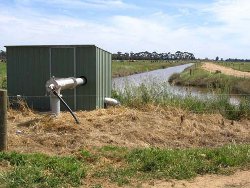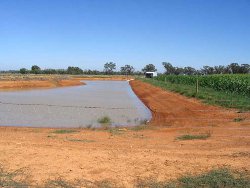Centre pivots and rural water authorities
Rural water authorities (RWA) such as Goulburn–Murray Water (GMW) encourage efficient irrigation practices and are generally receptive to proposals to install centre pivots or other irrigation developments. There may be capacity constraints on the particular channel that supplies your property that you need to consider during the planning stage.
Talk to the operations manager at your area office early in your planning process.
Water entitlement
You need to have a water entitlement to be able to take water.
Under the ‘unbundling’ reform of Victorian water entitlements you will need water shares (high and/or lower reliability), delivery shares and a water use licence.
Your current water entitlements will translate to these new ‘products’ and you can continue operating as you have been.
If you want to transfer water to or from your property, there are implications that you should be aware of. See your RWA for more information.
Irrigation supply
Pumping from the RWA channel
The simplest way to supply your pivot (or other pressurised irrigation installations) is to install your pump suction pipe directly into the RWA channel — known as a direct suction.
RWA approval is needed before you can install a suction pipe into the channel.
You will need to make an application through your local area office. Standard plans and design specifications are provided by G-MW.
Typically, suction pipes are set at 1.5 times the pipediameter below the supply level to maintain adequate submergence – for example, a 200 mm pipe will be set 300 mm below supply level.
The suction pipe is not affected by minor supply level variations that can affect Dethridge meter wheel flows.
Automation of the pumped system is readily achieved with a direct suction installation.
Metering
With a direct suction installation, water use is typically measured by a flow meter in the suction line. The RWA will specify the most suitable type of meter, and how it should be installed. You will need to pay for all of the works, including the meter. You will own the pipe, under a licence agreement with the RWA, but the meter will be owned and maintained by the RWA.
If you no longer need the Dethridge meter outlet to supply other parts of your property, it will be removed and any savings to the RWA may offset the cost of the new flow meter.
Murray Irrigation Limited (MIL) in NSW does not allow direct suction from their channels. A storage dam is required for centre pivot supply in MIL areas.
Pumping from a storage

As an alternative to pumping from a channel, the pump suction can be from a sump or a storage dam, which may be close to the meter wheel or remote from it.
Utilising a drainage reuse storage (existing or new) may be a cost effective way of supplying the pivot and reusing drainage water, groundwater and dairy effluent as well as channel water. (If the use of groundwater or effluent is planned, you should consider specifying your pivot with poly lined or stainless steel pipes.)
A storage needs to have sufficient capacity to meet management needs. A capacity of at least one day's pumping requirement is desirable. This is typically between 4 and 8 megalitres.
If you plan to construct a storage, you need to obtain a local government planning permit and comply with the Farm Dams legislation. Under this legislation, there is a limit to the capacity of new storages.
If you wish to build a storage larger than this limit, you need to provide water entitlement for it, either from your existing entitlement or by transferring in water. For more information, see your RWA.
A storage should be appropriately designed and constructed to avoid excessive seepage and evaporation losses. While some losses are inevitable, they should be minor.
Ordering water
Before proceeding with the installation of a centre pivot system you need to be satisfied that the RWA will allow you to order and take water at the times that you need.
On many channels, the RWA may not be able to allow you to frequently take water at night and weekends, which is attractive to people who can utilise off-peak electricity. In periods of peak crop water requirement you may need to be pumping almost continually, depending upon the system capacity of your pivot.
Ideally you would be able to take water on demand, or with say a day's notice (as may be possible on automated channel systems).
With the normal 4-day order requirement, if you want to irrigate, for example, twice a week it is often preferable to use a repeating order, which may be lodged up to a month in advance.
If you want to deviate from your order because of rainfall or excessively hot weather conditions, you need to advise the RWA. You should discuss your needs with your area operations manager.
If the RWA constraints are not acceptable to you, you may need to include a storage dam in your system to achieve the required flexibility. RWA supply timing is less critical with a storage dam.
Rural Water Authority assets

Often RWA channels and drains cross properties and may restrict potential pivot sites.
In some cases, the RWA may accept a pivot crossing a channel or drain to achieve the desired circle. A bridge would be needed for each tower crossing, or for a small drain a gravelled track could be constructed through the drain. These would need RWA approval, and to be designed and constructed to RWA specifications.
The cost could be substantial – particularly if, for example, up to 8 towers need to cross the channel or drain twice during a full circle. Such an arrangement would also limit pivot management options. The RWA will not accept fertiliser or pesticides, or drainage reuse water being applied by the pivot across a waterway.
Alternatively, the RWA may be able to abandon a particular channel if it can be rationalised (or reconfigured), for which some compensation may be available to assist with your on farm investment.
If a channel is small enough, it could be piped to facilitate crossing. While piping of a significant length of RWA channel is likely to be prohibitively expensive for a farmer, the RWA may be prepared to pipe a channel if the project is part of a water savings initiative. A contribution from the farmer may assist if the proposal is marginal for the RWA.
More information
It is worth exploring these options, talk to your area operations manager.